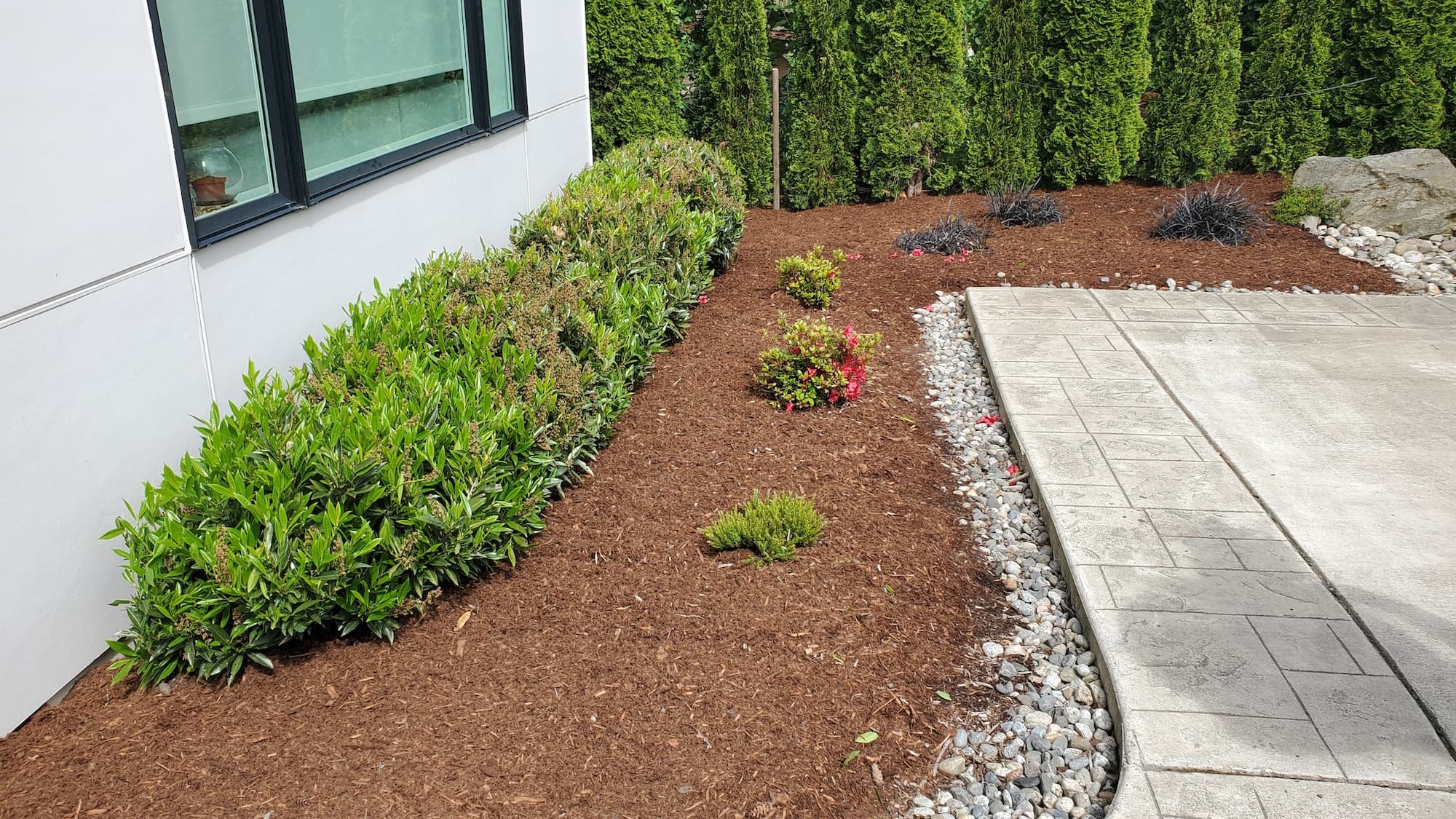West Seattle Spring mulch installation
Homeowner’s Issue
West Seattle yards deal with a specific mix of problems: heavy winter rain, shaded slopes, compacted glacial soils in upland pockets, and moss or ivy marching down from nearby ravines like Schmitz Preserve Park. Beds along Alki and Admiral see salt spray and more wind exposure, while pockets near Fauntleroy and Delridge hold moisture longer and get less sun. That means mulch choices and depths matter: too thin and weeds push through; too thick and crowns suffocate. Many homeowners call us after winter when beds look washed out, soil eroded from paths, or when HOA rules demand a tidy, uniform appearance.
Rainy seasons wash fines into drains and expose roots on slopes; home irrigation is often off for most of the wet months, so spring is the practical window to re-supply organics and correct grade. We focus on sustainable solutions: coarse wood chips for durability on exposed sites, fine bark for planting pockets, and compost underlayers where plants need a boost. We never use herbicides — we rely on hand-weeding, solarization when feasible, and organic soil amendments. If your property borders public greenbelt or steep banks, expect extra hauling and time to secure slopes. Our West Seattle experience shows the right mulch strategy reduces repeat weeding, improves drainage, and gives reliable curb appeal through the rainy months and into summer.
Our Quality Service
- Onsite assessment tuned to West Seattle microclimates and slope angles.
- Hand removal of invasive weeds and loose debris; rakes, wheelbarrows, and blower finish the bed.
- Sustainable mulch choices: local wood-chip, shredded bark, or compost top-dress.
- Proper depth: generally 2–4 inches, adjusted for plant types and slope.
- Erosion control on slopes with mulch anchoring techniques; no herbicides used.
Tools & timeline:
- Crew uses wheelbarrows, rakes, hand tools, and tarps. For steep or constrained yards we bring smaller crews and extra time.
- Typical mid-size yard: prep + install in one day. Large or slope-heavy sites: 1–2 days.
- We schedule spring slots before the heavy rainy stretch for best results.
What’s Included
- Clear-out: old mulch, debris, and manual weed removal.
- Bed prep: light soil loosening and compost top-dress where needed.
- Mulch delivery and spread at recommended depth (2–4”).
- Clean edges and blown paths/driveway cleanup.
- Haul-away options for green waste or dump disposal.
Options / Upgrades:
- Landscape fabric beneath gravel or paths (installed on request).
- Organic weed-control follow-up (hand-pull visits, mulching refresh).
- Compost or soil amendment (per cu yd pricing).
- Haul-away vs. city green‑bin drop-off (we can do either).
Before & After / Expectations
- Mess & noise: expect some noise from trucks and blowers and a day of work; crews clean up thoroughly.
- Access: we’ll need a driveway or clear route for wheelbarrows/truck within ~50 feet. Narrow alley access may add time.
- Debris: larger green waste may be hauled; city dump fees may apply for heavy volumes.
- Timeline: one-day installs for standard beds; allow extra for slopes, tree roots, or replanting.
Care tips for West Seattle:
- Watering: wait for drier spells after installation; light watering only for new plantings. Avoid deep watering during continuous rain.
- Weed pressure: spring and early summer are high—plan follow-up hand-weeding 6–8 weeks after install.
- Moss & ivy: shaded, compacted spots need dethatching, better airflow, and occasional re-mulch; we recommend replacing mulch annually in heavy-shade pockets.
- Slopes: check after heavy rains; anchor mulch with straw or stakes on steep banks.
FAQs
Q: When is best to mulch in West Seattle?
A: Late spring after soils start to dry but before summer heat—typically April–June depending on the year’s rainfall.Q: Do you use herbicides?
A: No. We use hand-weeding, solarization, mechanical removal, and organic mulches to suppress weeds.Q: How long will mulch last here?
A: Coarse wood chips can last 9–18 months; shredded bark may break down faster in shaded, wet areas—plan refresh every 12–18 months.Q: Do you handle steep banks and greenbelt edges?
A: Yes. We secure slopes and can haul debris from tight locations, but these jobs may require extra time and cost.
Call to Action
Ready to tidy up your West Seattle beds before summer? Book a free estimate and get a clear plan that respects slopes, salt‑exposed fronts, and HOA rules. We move quickly for spring windows and give honest timelines.
Email: neatandtidyseattle@gmail.com
Phone: 206-538-9344
Licensed • Bonded • Insured — local crews serving West Seattle, Admiral, Alki, Fauntleroy, and nearby neighborhoods.










